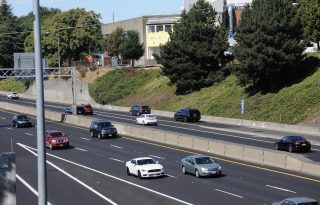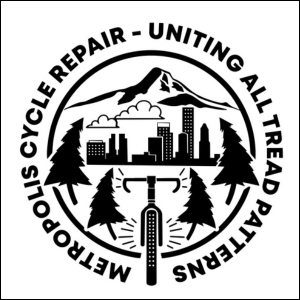
(Photos © J. Maus/BikePortland)
The Oregon Transportation Commission has reached a crossroads when it comes to the I-5 Rose Quarter megaproject.
The governing body of the Oregon Department of Transportation is poised to make a decision later this month about whether to drive ahead with the estimated $500 million project or whether to hit the brakes and perform a more thorough assessment of its environmental impacts.
Thus far, ODOT’s analysis of the project’s potential impact to the earth and to our community has been severely lacking. And that’s not just according to activists who oppose the project. Back in April, Metro’s senior planner described ODOT’s work on the project “inadequate and potentially misleading.”
In August, ODOT hinted that they’d heed the groundswell of community leaders and voices calling for a full Environmental Impact Statement (EIS) as part of the National Environmental Protection Act process they’re mandated to comply with. To date, ODOT has completed only an Environmental Assessment (EA) which is a less robust process.
As a decision from the OTC gets closer, pressure to slow down and do the EIS is building.
Advertisement
Willamette Week just reported that Oregon House Speaker Tina Kotek now supports calls for a full EIS. Kotek seems to have been convinced by the Portland Public School Board, who has already made their demands for an EIS clear and will consider another resolution on the project at their meeting later today.

PPS Board members are paying close attention because ODOT’s plans for widening I-5 would inch the freeway ever-closer to the playground and classrooms of students at Harriet Tubman Middle School. “The historical legacy from ODOT ignoring health and equity concerns voiced decades ago about building a freeway too close to a school has cost PPS millions of dollars that were used to make the air inside Tubman safe for students and had health and environment consequences for our students and the surrounding community,” the Board states in the resolution they’ll consider tonight (PDF).
Here’s more from PPS:
“Although the proposed project is immediately adjacent to PPS properties, in particular Harriet Tubman Middle School, neither ODOT nor the City meaningfully engaged with PPS during the planning process to assess the potential impacts, either short- or long-term, on the health of students and staff from environmental hazards of the freeway and the expansion or on the structural integrity of PPS facilities from incursions on PPS property during construction.
An initial review of the EA by PPS staff raised substantial questions about potential impacts on PPS properties, including risks to soil stability under the Harriet Tubman Middle School site during the construction process, increased air pollution, increased noise pollution, lack of school bus egress from Harriet Tubman Middle School with the removal of the Flint Street overpass, and shifts to traffic patterns in the vicinity of both Tubman and District headquarters…
In June 2019, ODOT convened a group of elected leaders and staff as well as community stakeholders to discuss the I-5 Rose Quarter Improvement Project in the Albina neighborhood.
To date, this group has met five times and made no substantial progress to substantially address issues raised by Portland Public Schools and the Albina Vision or offer alternatives to the current project plan.
At this time, the OTC has privately stated that it plans to unilaterally take action at its December 17 public meeting without addressing any of the troubling and significant impacts that the widening will have on students and community health.”
In the name of “climate justice” the PPS Board is expected to pass the resolution that reiterates their calls for a full EIS that addresses, “the long term health and environmental issues at Harriet Tubman Middle School caused by the I-5 freeway.” They will also formally state their intention to work with Albina Vision Trust on broader, neighborhood impacts of the freeway and share their findings with state legislators and the wider community.
“I’m definitely sympathetic to the folks who say we can’t do any more highway infrastructure because we’ve gotta’ get out of our cars because we’re killing the planet. I also know that, there’s no way people are going to stop driving tomorrow.”
— Tina Kotek, Oregon House Speaker
Also upping the pressure on ODOT and the OTC is a rally being planned by the No More Freeways group. On December 10th they plan to host an “Accountability for ODOT Rally” in front of the agency’s Portland headquarters.
As for Speaker Kotek, her call for an EIS will embolden the project’s opponents, but they shouldn’t count on her to help them stop it.
Kotek struck a compromised view of the project at the November meeting of the Portland Freight Committee. “I’m definitely sympathetic to the folks who say we can’t do any more highway infrastructure because we’ve gotta’ get out of our cars because we’re killing the planet,” she said. “I also know that, there’s no way people are going to stop driving tomorrow.”
Advertisement
“You have people saying any kind of improvement is increasing capacity and that’s a bad thing. I do believe we need to have more through traffic. The auxiliary lane is not expansion, it’s just better fluidity in the Rose Quarter and that’s what we need. And at the same time, I want people out of their cars and we need more transit. But again, going back to funding sources, how does transit get supported? We have the statewide payroll tax, but I’m sure TriMet thinks they need more money to expand capacity, so that is a conversation we should get to.
I think people should just not go to their corners and just keep lobbing bombs. And what I’m hearing from some parts of the freight community is that we were promised another lane. OK, I don’t think you were. So, what we need is an auxiliary lane. It’s like, come on people… we’re not going to get this done if we don’t stop fighting.”
— Jonathan Maus: (503) 706-8804, @jonathan_maus on Twitter and jonathan@bikeportland.org
— Get our headlines delivered to your inbox.
— Support this independent community media outlet with a one-time contribution or monthly subscription.


